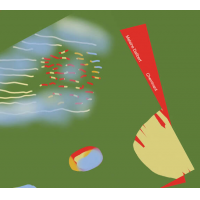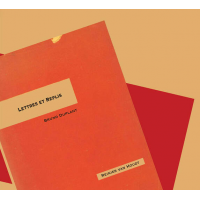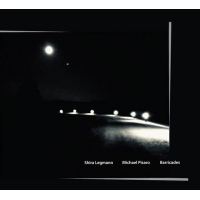Home » Jazz Articles » Multiple Reviews » Elsewhere Piano Series No.1
Elsewhere Piano Series No.1
 Melaine Dalibert
Melaine Dalibert Cheminant
Elsewhere
2019 With the release of Cheminant French composer and pianist Melaine Dalibert achieved the honour of being the first "return visitor" to Elsewhere; this album is the successor to the label's second release Musique pour le lever du jour which featured Dalibert playing one sixty-one-minute composition, with his use of note clusters and the piano's sustain pedal producing an impressive and memorable performance. Rather than covering the same ground again, on Cheminant he performs five shorter pieces, totalling fifty-two minutes. Dalibert shows a spirit of generosity by dedicating pieces to David Sylvian who created the album's artwork, the label's proprietor Yuko Zama, composer Peter Garland, and pianist Reinier van Houdt (see below). Across those four pieces, ranging in length from four-and-a-half to twenty-one-and-a-half minutes, Dalibert's writing and playing is readily identifiable as the source of his previous album, the music displaying the same fascination with sound and a willingness to let notes resound and linger in the air; one can almost visualise Dalibert savouring the beauty of what he has written. The fifth piece, "Etudes II," dates from 2017, and is in stark contrast to the preceding four, from 2018-19. Although it reveals the same care and attention to detail, it is performed at a brisk tempo and does not allow notes the same space to resound; consequently, its eleven minutes flash by and seem guaranteed to set toes tapping and to send listeners back for more. Yes, the whole album is well up to Dalibert's usual high standard.
 Reinier van Houdt / Bruno Duplant
Reinier van Houdt / Bruno Duplant Lettres et Replis
Elsewhere
2019 The joint credit for Lettres et Replis is fully justified by its music. The six tracks—three "Lettres" and three "Replis" ("repli" translates as "fold," not "reply")—are performances of letter-form scores by France's Bruno Duplant, personally addressed to Dutch pianist-composer Reinier van Houdt, containing letter sequences distributed across the page. As so often, listeners do not get any glimpse of the scores themselves, so are in no position to judge the realisations on the disc. But Duplant's scores are not prescriptive, and left a lot of interpretation open to van Houdt as the performer. The three "Lettre" tracks are effectively van Houdt's replies to Duplant's scores, in which he multi-layered his piano sounds. In "Lettre 1," he makes extensive use of the extremities of the piano keyboard, which would have been physically difficult, if not impossible, without multi-layering; the piece soon becomes a dialogue between the high and low ends, with some movement away from the extremes but no rapprochement between the two. Houdt allows plenty of space for the music to breath and notes to resonate, imbuing the piece with an impressive sense of drama. Although significantly different, "Lettre II" shares many of that track's strengths including its sense of space and drama; with many of the notes sounding damped, at times it gives the impression of prepared piano. "Lettre III" is different again, but is unmistakably of the same family, the three hanging together beautifully as a threesome. The three "Replis" pieces are sufficiently different from the "Lettres" to be distinguishable but, like them, work together as a group. On each of them, van Houdt combined his piano recordings with field recordings he made on John Cage's 100th birthday, September 5, 2012, along the Maas Harbour in Rotterdam, a combination which works well and produces some distinctively memorable passages. As with the "Lettres," these three have a consistent sound and style, largely down to those field recordings, which colour each of them. "Replis III," at nearly thirteen minutes the album's longest track and its closer, typifies the three and merits special mention; opening with the sounds of an outdoor field recording, it soon adds deep rich bottom-end piano which creates an atmosphere that persists throughout the piece, one that will conjure up different emotions for different listeners, all of them dark, melancholy and persistent. All in all, a haunting piece that brings this excellent album to a fittingly fine conclusion.
 Shira Legmann / Michael Pisaro
Shira Legmann / Michael Pisaro Barricades
Elsewhere
2019
"Instead of confining a listener within a small individual universe of the composer or the performer, Pisaro's piano pieces seem to take the listener to another dimension or another space—with some mystic power of induction, beyond the limited space that the solid, vertical texture of the piano sounds generally tend to create." There was a certain inevitability about Elsewhere releasing a Michael Pisaro recording. Not only has Yuko Zama been involved with Erstwhile during the years when Pisaro had a steady stream of albums released by the label, she has also been the designer on many of Pisaro's releases on his Gravity Wave label. In addition, Zama has sung Pisaro's praises in her reviews; the quote above coming from her review of Fields Have Ears (Another Timbre, 2010) for her blog View from Elsewhere. (Incidentally, each of the nine Elsewhere releases so far has included at least one musician who has featured on Another Timbre.) Barricades consists entirely of the sixty-three-minute title composition, written by Pisaro in 2018-19 for the Israel-based pianist Shira Legmann after he discovered that one of her favourite pieces of music was the 1717 harpsichord piece 'Les Barricades Mystérieuses' by the French Baroque composer François Couperin. Listening to Pisaro's fifteen-part composition, the most immediately obvious connection to Couperin's piece is its arpeggiated style, and its title "Barricades," maybe intended as a clue. It features Legmann's piano with Pisaro himself playing background sine tones, with those tones being the only sounds heard on the composition's two interludes, creating a dramatic atmosphere. On the thirteen studies that form the main body of the composition, piano and tones combine together effectively, creating music that encompasses a range of moods and emotions, and will be well received by established Pisaro aficionados and newcomers alike. This Piano Series consists of three distinctively different recordings, any one of which would have attracted attention and plaudits in its own right. It is a measure of the quality of the series that it is impossible to single out one of the three as being the best of the bunch; they are different but equal. Roll on Series No. 2...
Tracks and Personnel
Cheminant
Tracks: Music in an Octave (2018)—for David Sylvian; Percolations (for right hand) (2018)—for Yuko Zama; From Zero to Infinity (2019)—for Peter Garland; Cheminand (2018)—for Reinier van Houdt; Etudes II (2017).
Personnel: Melaine Dalibert: compositions, piano.
Lettres et Replis
Tracks: Lettre 1; Replis 1; Lettre 2; Replis 2; Lettre 3; Replis 3.
Personnel: Bruno Duplant: scores; Reinier van Houdt: piano.
Barricades
Tracks: Study No. 1; Study No. 2; Study No. 3; Study No. 4; Study No. 5; Study No. 6; Interlude No. 1; Study No. 7 Study No. 8; Study No. 9; Study No. 10; Study No. 11; Study No. 12; Interlude No. 2; Study No. 13.
Personnel: Shira Legmann: piano; Michael Pisaro: composition, electronics.
< Previous
Swing It, Brother, Swing!!
Next >
A to JazZ Festival 2019
Comments
Tags
For the Love of Jazz
 All About Jazz has been a pillar of jazz since 1995, championing it as an art form and, more importantly, supporting the musicians who create it. Our enduring commitment has made "AAJ" one of the most culturally important websites of its kind, read by hundreds of thousands of fans, musicians and industry figures every month.
All About Jazz has been a pillar of jazz since 1995, championing it as an art form and, more importantly, supporting the musicians who create it. Our enduring commitment has made "AAJ" one of the most culturally important websites of its kind, read by hundreds of thousands of fans, musicians and industry figures every month.

















